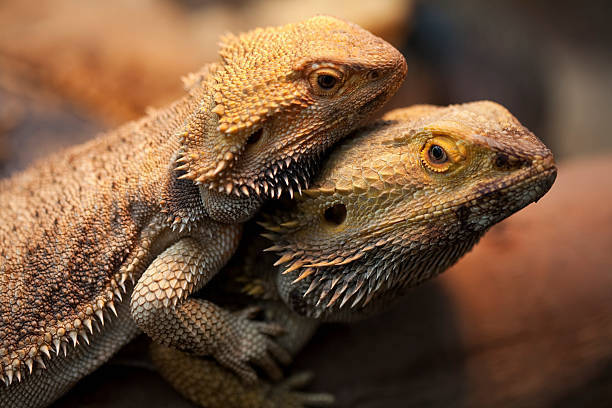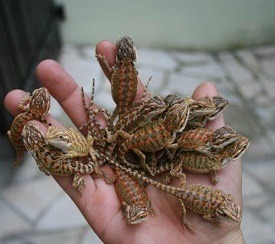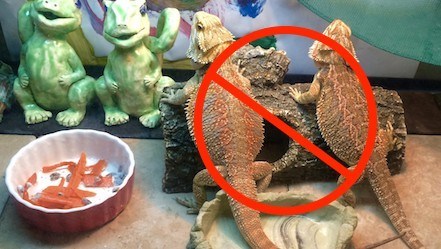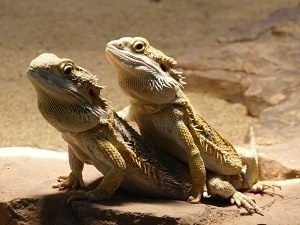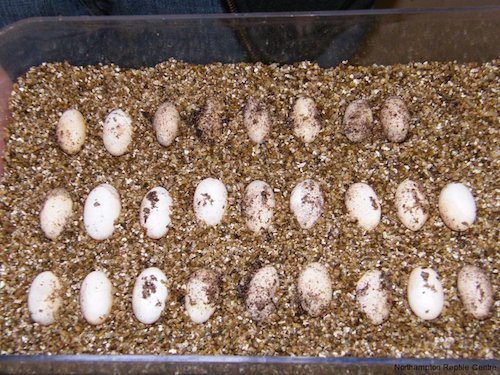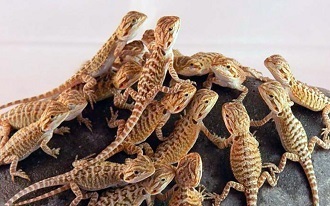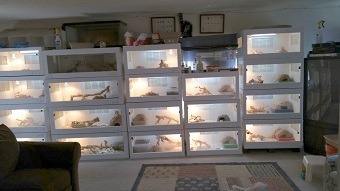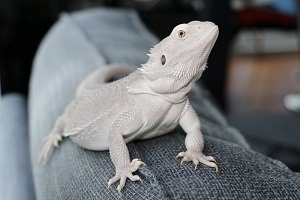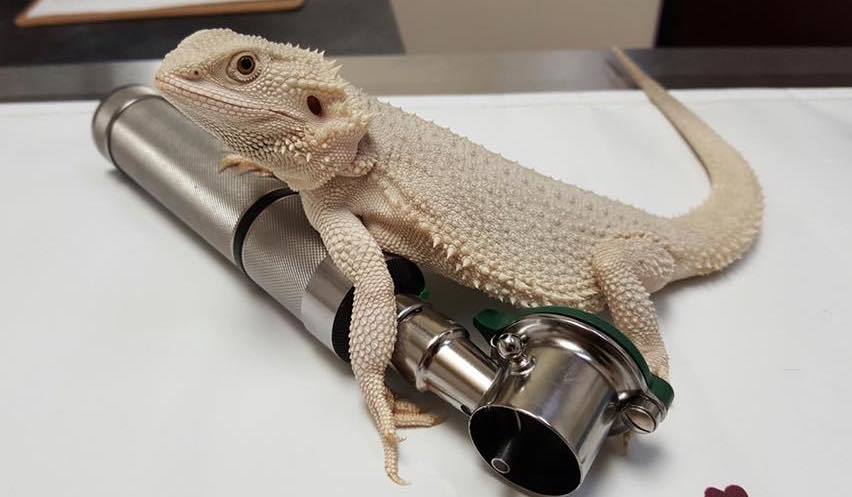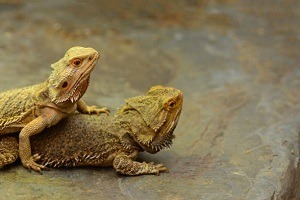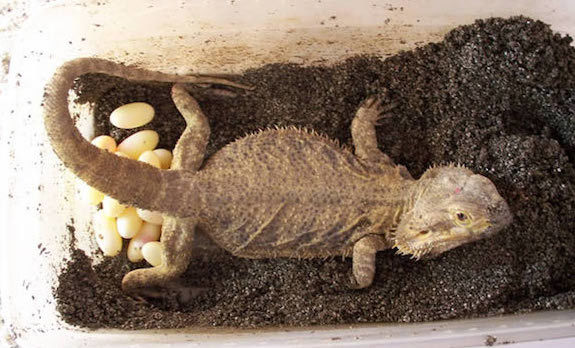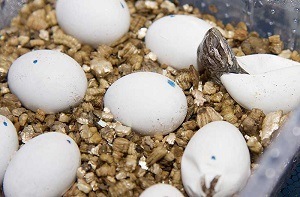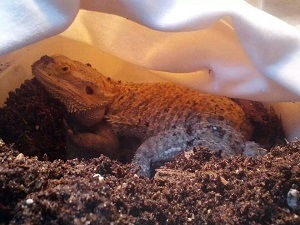While many first-time breeders/owners assume just placing a female and male bearded dragon together is all it takes… in reality, learning how to breed bearded dragons is actually so much more technical (not to mention expensive) than most pet owners realize!
In fact, simply placing a female and male bearded dragon together can actually have terrible and even fatal consequences for the dragons and even the babies if you breed the wrong morphs!
In This Article
What You Need to Know Upfront About Breeding Bearded Dragons
There is SO much that goes into breeding bearded dragons and as such, the decision to begin breeding should not be taken lightly nor made rashly.
Because of this it is very important for anyone looking to breed bearded dragons (opens in new tab) to do the proper research and educate themselves on everything that actually goes into this process to ensure the well-being of the father, mother, and babies!
It is my wish that this article on how to breed bearded dragons serves as an excellent overview of the steps one should take in the breeding process, to give you better clarification on if breeding is right for you or not.
However, the information presented here, while very thorough, is not indicative of the entire process.
Because of this, you MUST be willing to do more research on your own and ideally speak with a breeder to learn even more.
With all of this being said, if you’re looking to learn how to breed bearded dragons, start by reading this article to get an idea of everything you can expect and the steps you need to take for optimal success!
*Use the Table of Contents below for quick navigation!
Can a Male and Female Bearded Dragon Live Together?
In short? Sure. But, should they? NO!
Here’s why: Your male bearded dragon will be acting on his natural instincts to “breed” the female and this in turn will cause her a lot of stress and even physical harm.
Think about it this way, in the wild a female bearded dragon can run away from horny males… but in a tank? She has nowhere to escape to.
Forcing a female to cohabitate with a male is just cruel.
In fact, there are many owners who will tell you that their females who lived with males died shortly after laying eggs or became sickly from the stress. Just don’t do it.
Also, territorial disputes can erupt between bearded dragons leading to fighting, injuries, or even death.
What will likely happen is the smaller of the two dragons will get completely beat up on and either horribly maimed or even killed.
It’s not worth risking.
What Does Bearded Dragon Mating Behavior Look Like?
Bearded dragons that are ready to mate will display several key behaviors that indicate it’s “that time”. Please consider the following behaviors below…
Male Bearded Dragon Mating Behavior
It’s quite hard to identify a male bearded dragon unless you know what you’re looking for (hemipenis). But when a male bearded dragon is ready to mate, you will notice his beard turning black unprovoked and him bobbing his head quite a bit.
Also, if there is a female in his presence that he can see, you may begin to notice him stomping his front feet at her and even chasing her around quite a bit, trying to mount her.
Also, during the mating process, the male bearded dragon will bite the neck of the female bearded dragon to try and hold her still while he mounts her.
In some extreme instances, this may even lead to her skin being torn.
Let’s just say male bearded dragons are not exactly the most romantic and consenting species.
This further emphasizes why it is so important to keep male and female bearded dragons separate.
The only time to bring them together is during the initial brief periods of trying to mate them!
You can see the aggressive mating behavior of the male in the video below…
Female Bearded Dragon Mating Behavior
When it comes to female bearded dragons, they’re not nearly as showy as their male counterparts.
However, a female who is ready to mate will likely demonstrate arm waving in reciprocation to his head bobbing.
How Old Does a Bearded Dragon Have to Be to Breed?
Bearded dragons are not considered sexually mature until they are at least 18 months of age.
Because of this, breeding any dragon under this age should be the furthest thing from your mind.
Allow your dragons to grow up healthy, strong, happy, and reach at least 18 months (but ideally 24 months) of age before you even consider breeding them.
How Many Babies Does a Bearded Dragon Have at One Time?
When a female bearded dragon becomes pregnant or is “gravid”, she can lay anywhere from 1 to 4 clutches for a single pregnancy.
In each clutch, you can expect around 20 eggs or so… but in some instances up to 30!
So, just to do the math… on the extremely high end it is possible for female bearded dragon to lay 80 to 120 eggs in total across several clutches from a single pregnancy!
Naturally, with the possibility of a 100+ babies hatching in a rather short period of time, there are some serious variables you should consider.
The first variable is cost.
It is not uncommon for a clutch of babies to go through thousands of crickets a month.
And when you have multiple clutches? Prepare to go through anywhere from 2000 to 4000 crickets a month. Seriously.
Make sure you have enough money for that many feeders.
Also, you need to be prepared to devote at a minimum around 2 hours a day caring for the babies.
From feeding them to bathing them, to tracking their growth and ensuring they’re all thriving and healthy… caring for these little guys can definitely eat up a good amount of time daily.
All potential breeders should only consider going through with the breeding process if they are able to devote 2-4 hours to caring for babies daily.
Do Bearded Dragons Have a Breeding Season?
In their native habitat of Australia, yes. Bearded dragons mate in the spring after waking up from a nice relaxing brumation.
However, in captivity, bearded dragons can essentially mate at any time of the year.
But despite this, many people will advocate that you try to emulate their natural cycles as much as possible and allow them to brumate and then mate in the spring (more on that below).
How to Breed Bearded Dragons in 10 Steps
As aforementioned, breeding bearded dragons is no walk in the park and should only be attempted by responsible owners who have done all the legwork and research to ensure the best possible outcome for all dragons (and hatchlings) involved.
And since I am not a breeder myself but simply an educated reptile owner, I cannot possibly cover every detail any potential breeder SHOULD know ahead of time.
What I can do, is offer a great overview of what you can expect to help clarify if this process is a good fit for you or not.
Read on to discover the some of the crucial steps on how to breed bearded dragons.
1. Meet with a Breeder
Listen, you wouldn’t jump blindly straight into a new career path without at least getting the advice of friends and family or even someone who works in that field…right?
So, why would you jump head first into breeding a new animal/reptile/whatever without consulting someone who knows something about it first?
Many first-time breeders will make the assumption that breeding bearded dragons will be “easy” or “fun” or “cute”… but honestly, nothing could be further from the truth!
Sure, seeing the hatchlings hatch and grow up and find homes is a really rewarding fulfilling… but what if you can’t find homes for all the hatchlings?
What if, some of the hatchlings have serious health issues?
What if your female lays 4 huge clutches and your hatchlings are eating you out of house and home? What then?
This is why it’s so important to consider all the possible scenarios, good or bad, and meeting with a breeder will help you realize just how many scenarios there are for you to actually consider before making a decision.
2. Learn About the Lineages and Genetic Makeup of the Dragons You Want to Breed
If you thought you could just breed any two bearded dragons together, then I am sorry to say you’re wrong.
In order to produce the healthiest, most attractive of hatchlings, you’ll need to do some research on the genetic makeup of each parent dragon.
Why?
Well, simply because certain morphs don’t mesh well together and can lead to hatchlings that are sickly, weak, or even likely to die extremely young. Also,
3. Take Your Bearded Dragons to the Vet
Before any mating or cohabitation even occurs, make it a point to take both of your dragons to the vet to ensure they are actually healthy enough to be bred.
Your vet will weight them, measure them, and conduct the proper testing to determine whether or not either dragon is carrying any viruses.
Also, while you’re at the vet make sure to inquire about possibly brummating your dragons.
Make sure the vet finds them health enough to hunker down for the winter.
4. Prepare Your Bearded Dragon for Brumation
Although probably not your ideal scenario, keeping in line with the natural cycle of things means allowing and encouraging (not forcing) your bearded dragons to brumate.
If your vet gives you the go-ahead to allow your bearded dragon to brumate, then definitely consider starting that process sometime in the fall.
After waking up from brumation, you should notice both dragons displaying behaviors that indicate they are ready to breed (see above).
At this point, you can start thinking about putting them together AFTER taking the following steps below first.
5. Prepare Your Female Bearded Dragon with the RIGHT Supplements

To help prepare your female to lay the healthiest clatch possible, put her on a diet that incorporates a daily supplement of both calcium and Vitamin D.
You’ll want to give her this supplement for at least two weeks before any breeding attempts to both help her eggs have plenty of calcium and keep her from becoming calcium deficient after laying the eggs.
Click HERE to read about the best calcium powders for bearded dragons
6. Consider Preparing a Separate Breeding Tank
To avoid aggression from territorial issues (or at least, minimize the risk), consider putting together a new habitat for your male and female to breed in.
By introducing them to a new habitat, you will be lessening the chances of them fighting. Also, it is really important the tank size is adequate for both bearded dragons.
So, try to aim for at least 75 gallons, but ideally 100 gallons or 120 gallons.
Make sure you have rocks and branches in the habitat as well.
The rocks will give them places to hide from one another and chill, whereas the branches will be great for them to climb on.
Click HERE to read more about setting up the proper habitat
7. Start Allowing Your Bearded Dragons to Mate
Once your female bearded dragon has been on her high calcium and Vitamin D diet for a few weeks, consider placing her with your male for brief periods of time to allow mating to occur.
You’ll always want to be present and on hand to supervise and ensure no fights break out.
It only takes a split second for a limb to be horribly maimed in a fight.
If your bearded dragons get along and show no signs of aggression over the course of many meetings, you can consider allowing them to stay in the habitat for longer periods of time.
However, it should be noted that you still should be present to supervise.
8. Provide a Lay Box
Once your female is pregnant, you will need to make sure you provide her with a proper box to lay her eggs in over the course of the next month or so.
This box should contain be at least an eight-gallon container and should contain at minimum six inches of topsoil or potting soil in addition to some sand.
Make sure this mixture is damp enough that she will be able to dig in it when she tries to bury her eggs.
You’ll ideally want a mixture that slightly clumps together.
9. Purchase Your Incubator

Now that the eggs are laid and buried, you’ll need to transfer them to an incubator for them to develop.
Here, they’ll remain until hatching months later. An important side note about fresh eggs is that you should avoid handling/touching them as much as possible.
Transfer them to the incubator and leave them be for a few days to ensure minimal interference with the developing embryo.
After a couple days or a week of resting, you can now grab a flashlight and check whether the eggs are fertile or not (if you have any doubts).
Simply shine it through the egg and try to spot the pink embryo. No embryo? No baby bearded dragon.
You’ll want to incubate the eggs for anywhere from 60 to 90 days, depending on the temperature.
The ideal temperature is going to be between 80 and 85 degrees Fahrenheit.
And for humidity, you’ll need it between 30 and 40 percent to keep the eggs from drying up.
10. Set Up Your Baby Bins/Care for Your New Hatchlings
Once your babies have hatched, you’ll want to immediately divide them into separate bins to ensure they have plenty of room.
This will also help minimize the chances of tails or limbs being nipped at as well.
Naturally, each bin is going to need to be set up in a familiar fashion to that of the adult’s tank.
So, you’ll need a UVB bulb, a heat source, the right substrate, and all the other fixings. Also, note that baby bearded dragons prefer slightly hotter temps in their setups.
Aim for temperatures of around 110 degrees Fahrenheit for a basking temperature.
Typically, you’ll want anywhere from 4 to 6 babies per bin, depending on bin size. Once the babies grow larger, you’ll likely want to separate them even more to keep things copasetic.
How Long After Mating Does a Bearded Dragon lay Eggs?
On average, you can expect your female bearded dragon to lay her eggs anywhere from 4 to 6 weeks after becoming pregnant.
Is My Female Bearded Dragon Laying Eggs?
If you think your female bearded dragon is laying eggs or about to, relax!
Regardless of whether she’s been with a male recently or before you got her, female bearded dragons can actually lay infertile eggs much like chickens.
If your bearded dragon’s stomach is growing, she’s lethargic, and beginning to dig in her enclosure, chances are she’s gravid and going to lay her eggs soon.
How to Help a Female Bearded Dragon Lay Eggs
If you’ve determined your female bearded dragon is going to lay eggs, the best thing you can do for her is to provide her with a laying box and make sure she has access to extra food to fuel her body.
Also, make sure she is getting extra calcium on a daily basis until she lays her eggs.
Gravid bearded dragons can become calcium deficient easily as much of what their body produces goes towards their eggs.
And once those eggs are laid, their body is very weak without the calcium.
Click HERE to read about the best calcium supplements for bearded dragons
In Conclusion
As I’m sure you now understand, breeding bearded dragons is no walk in the park.
There is a lot that goes into making sure the bearded dragons are healthy, safe, and as stress-free as possible.
Also, one must consider such variables as genetic makeup to ensure that the babies are both healthy and attractive.
Many people assume there is great money in breeding bearded dragons as it has become rather trendy. However, 9 out of 10 times this simply is NOT the case.
Between the cost of feeders, setup, the incubator, and time spent caring for the babies… breeding can turn into more of an expensive hobby than a lucrative business.
Now, this article is by no means an attempt to try and “scare” you away or discourage you from breeding.
It is simply important to present the information in a matter-of-fact way to help those considering breeding.
Also, I should note one final time that I am NOT a breeder and this article can’t possibly encompass all that you need to know about breeding.
Because of this, it is of the utmost importance that you find a respectable breeder to talk to and do your own research on this topic.
Your best bet at successful breeding and making any money whatsoever will stem from doing your homework on this process before diving straight in.
If you take the time to research, ask questions, and really think things through… then I am sure if you decide to move forward you will make an excellent breeder!
I hope this article proved helpful in giving you a better understanding of how to breed bearded dragons.
If you have any questions about how to breed bearded dragons, feel free to leave them in the comment section below.
I will do my best to answer them but no promises as I am not a breeder.
